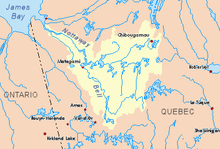|
Fortier River (Panache River tributary)
The Fortier River is a tributary of the north shore of the Panache River flowing in Eeyou Istchee James Bay (municipality), in Jamésie, in the administrative region of Nord-du-Québec, Quebec, Canada. This river successively crosses the townships of Urban and Carpiquet. Forestry is the main economic activity of the sector; recreational tourism activities, second. The Fortier River valley is served by the R1051 forest road (east-west), which runs north. The surface of the Fortier River is usually frozen from early November to mid-May, however, safe ice circulation is generally from mid-November to mid-April. GeographyThe surrounding hydrographic slopes of the Fortier River are:
The Fortier River originated in Eeyou Istchee James Bay (municipality), at the mouth of an unidentified lake (length: 1.5 kilometres (0.93 mi) altitude: 418 metres (1,371 ft)). The mouth of this lake is located at 2.3 kilometres (1.4 mi) south-west of the summit of a mountain (elevation: 502 metres (1,647 ft)) which straddles the boundary of the townships of Picquet and Urban. This mountain has a strong slope on the east side, facing Lake Podeur. The mouth of this head lake is located at:
North of the mouth of the Panache River;
From the mouth of the head lake, the Fortier River flows over 17.3 kilometres (10.7 mi) according to the following segments:
The Fortier River flows on the north shore of the Panache River. The latter flows to the east bank of the Wetetnagami River, which generally flows northward to the Nicobi Lake. The latter is the head lake of the Nicobi River. The latter flows north to discharge on the southeast bank of the Opawica River. The latter goes back to the north until it meets the Chibougamau River; this confluence is the source of the Waswanipi River. The course runs westward through the northern portion of Lake Waswanipi, Goéland Lake and Olga Lake, before pouring into the Matagami Lake which in turn flows into the Nottaway River, a tributary of Rupert Bay (James Bay). The confluence of the Fortier River with the Wetetnagami River is located at:
ToponymyAt various times in history, this territory has been occupied by the Attikameks, the Algonquins and the Crees. The term "Fortier" is a family name of French origin. The toponym "Fortier River" was officialized on December 5, 1968, at the Commission de toponymie du Québec, when it was created.[3] See alsoNotes and references
|
||||||||||||||||||||||||||||||||
